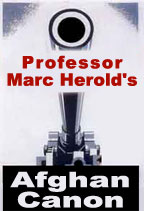Hat trick: Selling brand Karzai
Afghanistan as an empty space, part three. See parts one, two and four.
by Marc W. Herold
Departments of Economics and Women's Studies
Whittemore School of Business & Economics
University of New Hampshire
POSTED MARCH 10, 2006 --
The U.S. Government and its Afghan client spare no efforts to craft, project and publicize an image of progress and governance under Afghan President Hamid Karzai. The United States authorities admit "victory in the long war ultimately depends on strategic communication," that is, upon marketing a particular, constructed image of reality.1 In other words, reality is far less important than effectively selling an interpretation. I shall briefly focus upon four forms that this vast marketing effort takes in selling "Brand Karzai."
The first is an image of a revitalized country under the leadership of a responsible, Western-oriented leader who is symbolized by modern buildings sprouting up and new asphalt strips going off into the horizon. The second is the huge media fanfare raised over the "successful" elections held in 2004 and 2005. Thirdly, the corporate media entertains the public with a bouquet of insignificant spectacles deemed to convince the reader that happiness has returned to Afghanistan: beauty salons are opening up, kids are flying kites, adults converse via cell phones, and the "hideous" burka is on the way out (replaced timidly by miniskirts on sale in a boutique in Herat2 and western fashions in Kabul). Lastly, the corporate media assists in establishing the credibility of 'Brand Karzai' by reporting on his incessant international travels, seeking to legitimate him as a statesman of international stature.
The centrality of image over substance as regards Karzai was revealed in the first weeks after the Taliban was bombed out of power in December 2001. Besides being a known and compliant asset of the West, Hamid Karzai could be marketed to the general public as a man of taste, chic, and aristocratic heritage. Within a month after the Taliban had abandoned Kandahar, the western press was promoting Afghanistan's "Mr. Chic." Karzai was said by the poised BBC to have,
broken new sartorial ground by marrying classic tailoring with ethnic fashions, in a combination which may breathe new like into the way leaders dress around the world. Mr. Karzai has a knack for combining classic and ethnic. One of his trademarks is to layer Nehru-collar shirts, waistcoat and jacket. He is also well known for sporting Astrakhan hats...3
By late January, the press was reporting that Karzai was pleased with his fame as a fashion icon (though hoped that he could become more than a "fashion plate").4 Georgie Anne Geyer added,
The Washington Post's congenitally snippy Style Section went furthest in falling all over itself, when writer Robin Givhan wrote breathlessly of Karzai that "there is a lot of Hollywood" in the man. "Many are captivated by his signature hat and his billowing cloaks in vivid shades of emerald green or exuberant ribbon stripes," she went on. "They like his flowing shirt with its banded collar. Karzai has the natural sex appeal of a Sean Connery rather than the situational sex appeal of, oh, Secretary of Defense Donald Rumsfeld. Karzai is an alpha male with a peacock's flamboyance. Might other men follow? Designers can only dream."5
By mid-2002, Karzai had toured many Western capitals establishing himself
as a well-educated, westernized and stylish [leader]...He won further praise from the Gucci fashion house for his trademark green-and-white chapan -- traditional Uzbek coat -- and his ceremonial karakul hat.6
The western press had successfully leveraged Karzai's fashion style into statesmanship. But many Afghans well knew that "Karzai is not the president of Afghanistan, B-52 is president."
Merely being fashionable was an insufficient sales pitch to market Brand Karzai. The new "statesman" needed to be shown as actually accomplishing something tangible. The choice emerged in the guise of displaying Karzai presiding over the modernization of Kabul (and to a lesser extent Afghanistan -- which was more difficult to show as Karzai's influence outside of Kabul was limited). He would be prominently shown inaugurating new constructions and cutting ribbons of finished constructions. The favorite modern icons were highways and luxury hotels.
An early centerpiece of such effort took place on November 10, 2002, when Karzai and U.S. Ambassador Robert Finn officiated a ground-breaking ceremony to mark the first day of construction of Afghanistan's main highway, known as "Highway 1," from Kabul to Kandahar.7 The international press was present and recorded the solemn moment: CNN even published a photo of Karzai praying at the ceremony.8
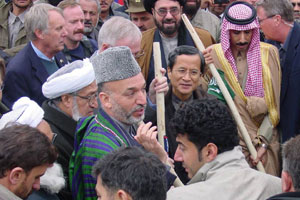
A year later on December 16, 2003, Karzai with U.S. Ambassador Khalizad at his side, cut the ribbon to inaugurate the newly repaved highway. U.S. Special Forces swarmed around the area, Apache helicopters whirred overhead, and the photo op was deemed a success. Karzai proclaimed, "we are rebuilding Afghanistan, bringing back to us what we all desired."9 What didn't make the headlines was that Highway One epitomizes money wasted on reconstruction. A former Afghan Finance Minister said that the government could have repaved the road for $35 million, but USAID ended up paying $190 million. He goes one further, saying that more than 90 percent of the more than $1 billion spent on about 400 United Nations projects in Afghanistan in 2002 was wasted.10
In April 2004, Karzai donned a hard-hat and with his entourage of armed U.S. DynCorp guards, inaugurated the building of the five-star Hyatt Regency Hotel in Kabul (fittingly located opposite the U.S. Embassy), another media spectacle.11
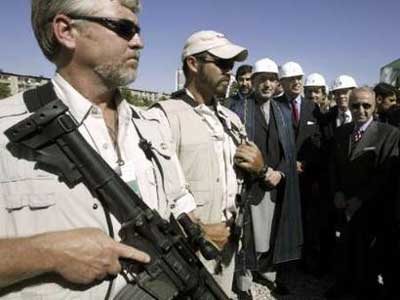
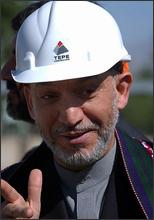
In April 2005, Karzai launched the construction of another major highway, linking Kandahar with Herat. At the inauguration photo op, he said, "we are starting a very important part of the reconstruction of our country, which is the reconstruction of the roads."
Brand Karzai was further promoted at the ribbon-cutting ceremony on November 5, 2005, of a lavish, five-star, reconstructed hotel, the Kabul Serena, financed by the Agha Khan and the World Bank (which has contributed over $900 million to the country since 2002 ($456mn in grants and $436mn in loans). The new hotel is part of "Kabul's extreme makeover."12 The high-visibility festivity and ribbon cutting was widely reported upon. Numerous photos were shot, displaying an interior worthy of the best in San Francisco.
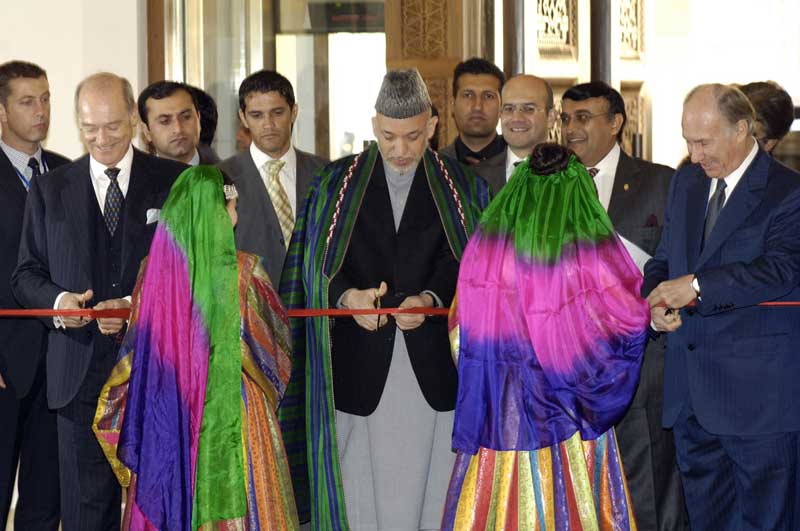
As Daniel Cooney wrote,
"with its large swimming pool, health club, pastry shop, two restaurants and neat mustard-colored exterior, the hotel contrasts sharply with its surroundings. Crippled men compete with ragged street children on the pavement outside to beg for change from passing cars. About 300 yards away is the Murad Khani slum, where thousands live in flimsy shacks next to open sewers."13
Further inauguration events presided over included beginning construction of Afghanistan's first private university on March 21, 2005, the American University of Afghanistan located off the Dar ul-Aman Road in west Kabul.
The second element in marketing Brand Karzai -- already dealt with in previous sections of this essay -- was to announce with tremendous fanfare and coverage -- everyone remembers the endless stream of photos of Afghan ballots -- the successful completion of presidential and parliamentary elections. We were all treated to spectacles of ballot boxes crossing mountains and rivers, a sure sign that democracy was finally on the move in Karzai's Afghanistan.14
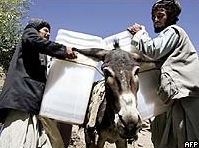
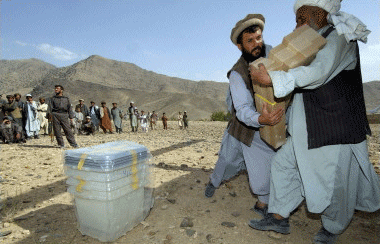
"For the first time in 5000 years..."
Some of press coverage was triumphal. A U.S election observer announced,
On Sunday September 18th [2005], Afghans went to the poles for the first time in more than 5000 years to vote for members of their new Parliament. Voters cast votes for the Wolesi Jirga (Lower House of the National Assembly) and Shoraiy Wolayety (Provincial Councils). The free elections were part of the Bonn agreement signed four years ago following the defeat of the Taliban regime in 2001. Nearly 6,000 candidates completed for 249 seats in the Wolesi Jirga and for the 34 provisional councils. About 25% of the seats were reserved for women. Candidates included medical doctors, teachers, businesspersons as well as former Communists, members of the Taliban and warlords.15
Others were satisfied with qualifying the elections as being a "landmark."16 The more academic commentators expressed dismay and concern over the very low turn-out in the September parliamentary election.17 Other commentators noted the substantive difference between a procedual versus republican democracy.18 But never mind such complicated chatter, the media marketed a sustained pitch stressing "success." Viewers were deluged with a sea of ballot boxes. After all, $350 million had been disbursed by the U.N. -- the equivalent of one-third of all completed reconstruction projects between 2001-5 -- in these elections.19
The third major aspect of selling Brand Karzai is to present images and stories describing how happiness has returned to the blighted nation. Favorite themes portray laughing children flying kites again, a re-opened golf course, flourishing beauty salons, modern city dwellers conversing via cell-phones, the demise of the dreaded burka, the return of western fashions, etc. Such human-interest stories are aimed to reassure a reader that under the statesmanship of Hamid Karzai the country has returned to the fold of the world's civilized countries.
Even while the Taliban were still being driven out Afghanistan's cities, the Western press was publishing articles about boys flying kites again.20 The implication was that normalcy and happiness were on the way back. For the past four years, countless stories have been devoted to the theme. The day after the 2004 presidential election, an Afghan boy was shown flying a kite above Kabul:
 Source: Richard Wainright |
Another theme prominently written about is the return of sports to Afghanistan, from soocer to cricket, bodybuilding to golf. Numerous articles describe the restoration of the Kabul Gold Club in the Bandi Qarha section of Kabul.21 But, a revealing footnote to the happy scenes of golfers teeing off, is the Afghan National Army tank patrolling the nearby hills.
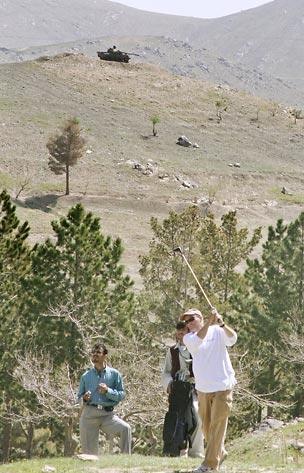 Steve Kelley of the Seattle Times takes a swing |
A constant endlessly repeated theme has been the possibility of women "becoming beautiful again" in post-Taliban Afghanistan. Countless articles (and even a film) describe the flowering of Kabul's beauty salons. Some time before their arrival, western journalists were already informing us about the high heels and western dress Afghan women were wearing beneath the burqa. Articles with titles such as "Opening Afghan Eyes with Mascara and Beauty Classes" received wide coverage.22 Similarly, a stream of articles described in every detail the Kabul Beauty Academy, including its first class of graduates (see below).23 What many seem to misunderstand is that the burka provided and still provides a sense of security and privacy.24
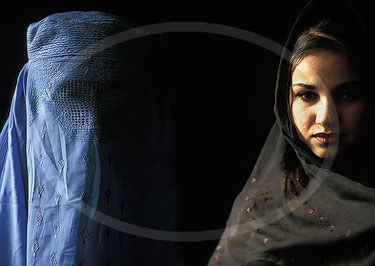 Palawasha, one of the first graduates of the Kabul Beauty School (source: PictureContact.com) |
Moreover, as Humera Khan so eolquently noted, the question is more about power than clothing,
"the issue of the burqa in Afghanistan, or anywhere else in the Muslim world, is not about the garment itself. Women wore such clothing even before Islam and will continue to do so as a matter of choice...while the Taliban were imposing their beliefs and reducing freedom on one side, the same can be said of the male-dominated and often misogynistic fashion industry on the other."25
The image of a modernizing Afghanistan under Karzai is also promoted by numerous articles on the telecommunications revolution underway. Afghans are portrayed buying cell phones in newly opened shops, engaging in incessant SMS messaging, sending romantic messages, etc.
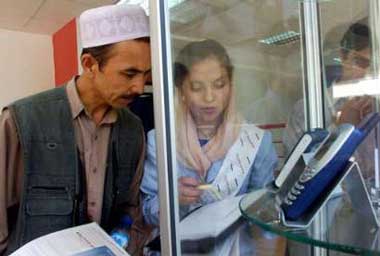 |
The arrival of Bollywood movies and western fashions receive ample coverage.26 Some youth sport baseball caps, frayed blue jeans, denim jackets sleeveless shirts, imported t-shirts in Kabul. In late 2005, Aresh Azizi opened a western-style boutique in Herat featuring a mannequin "with a flawless face and marble-smooth arms...[wearing] a miniskirt." Azizi proudly announced, "her name is Venus."27 Articles lament the passing of good times "when miniskirts and Western fashion were in style in Afghanistan."28 USA Today's Mark Memmott penned an article "Afghanistan' 'A Good Country Again' From Fashion to Hollywood, Outside World in Making Inroads."29
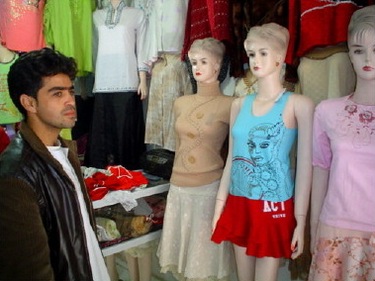 |
Further "goods news" is written about: Afghans heading for the Kabul City Center shopping mall; Coca-Cola returning to Kabul, opening a new bottling plant; and the New York-based J. Walter Thompson advertising agency set up a joint venture in Kabul.30
Another major element in marketing Brand Karzai is widely publicizing the U.S. client's international junkets. Hardly an international meeting goes by without the telltale green manteled Karzai being on public display. Other junkets include receiving honorary degress and medals of all sorts, again providing for wonderful photo ops. A spectacular photo op was provided when Karzai received the 2004 Liberty Medal at Indepence Hall in Philadelphia:
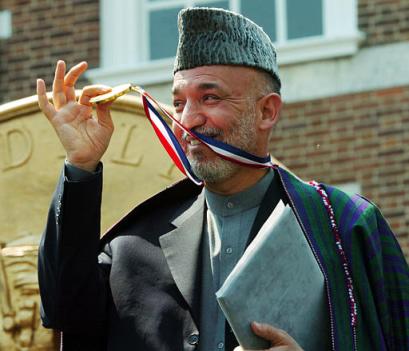 |
One puzzles why the international media devotes so much attention to a leader whose existence depends upon 20-30,000 foreign troops. Why not devote similar print and photos to leaders from important international players like Brazil, or Nigeria?
Both the U.S. Government and the mainstream corporatre media spare no efforts in seeking to promote Karzai as a respectable statesman of international stature. Their efforts began with a focus upon fashion, moving on to reporting on high-visibility construction projects in Afghanistan and on Karzai's international voyages, heralding with great fanfare the successful completion of two national elections, and all the while trying to portay the return of normalcy and happiness to Afghanistan by a deluge of human interst stories (about kite-flying, golf, weight-lifting gyms, beauty salons, western fashions, etc.).
Coming next, Part four: The U.S. military strategy in Afghanistan.
Footnotes
1. See James P. Pinkerton, “American Outwitted on World Stage. Can America Win a Sustained War in This Media Age?” The Cincinnati Post (February 24, 2006).
2. Fridon Poya, “Mini-skirts, Dating in Afghanistan’s Heart After Warlord Leaves,” Agence France Presse (November 28, 2005).
3. See “Picture Gallery: Afghanistan’s ‘Mr. Chic’,” BBC News (January 17, 2002).
4. “Aghan’s Karzai Aims to be More Than a ‘Fashion Plate’,” Reuters (January 21, 2002).
5. In her “Karzai’s Colorful Clothes Show More Than Good Fashion Sense.”
6. “Hamid Karzai: Shrewd Statesman,” BBC News (June 14, 2002).
7. USAID, “Ground Breaking Ceremony for Kabul-Kandahar-Herat Highway Reconstruction Project” (Washington D.C.: USAID Press Office Release, November 10, 2002).
8. Diana Muriel, “Work Begins on Afghanistan’s Highway,” CNN.com (November 10, 2002).
9. Reported in Stephen Kaufman, “Afghans Celebrate Reconstruction of Kabul-Kandahar Road,” USINFO.State.Gov (December 16, 2003). Photos of the occasion may be found in a news release of the Louis Berger Group.
10. Tony Poston, “The Battle to Rebuild Afghanistan,” BBC News (February 26, 2006).
11. “Karzai Hails New Afghan Hyatt," Seattle Post-Intelligencer (April 17, 2004 with photo of Karzai in hard hat by Emilio Morenatti).
12. Daniel Cooney, “New Hotel Part of Kabul’s Extreme Makeover,” Associated Press (November 8, 2005).
13. Cooney, op. cit.
14. For an interesting and beautiful set of photos of the 2004 elections.
15. Diane Tebelius, “For the First Time in 5000 Years...” Diane in Afghanistan (September 20, 2005).
16. Daniel Cooney, “Election Results in Afghanistan Finalised,” The Scotsman (November 13, 2005).
17. For example, see footnotes # 28 and 29 herein.
18. See Jan Qarabaghi, “Afghanistan: What Kind of an Election, What Kind of a Democracy?” Afghan Observer (2005).
19. Jan Qarabaghi (op. cit.) notes, “I would like to draw the readers’ attention to the staggering costs of the up-coming elections (these costs are currently paid for by the generosity of the foreign powers occupying Afghanistan): To conduct and supervise the elections, over 150,000 election officials and workers have been employed for a period of over three months. The total personnel and logistical cost of the undertaking has been estimated to be over $158 million (the cost of last year’s presidential election was about $200 million). Based on these figures, election costs per candidate turn out to be over $27,000. The cost per elected MP will be $634,538 (=158,000,000÷249).”
20. For example, see “Kite Gambling Returns to Afghanistan,” The Holland Sentinel (March 31, 2002).
21. For example, see Steve Kelley, “Afghanistan’s Kabul Golf Course a Symbol of Survivial,” The Seattle Times (April 28, 2005).
22. Hamida Ghafour, ”Opening Afghan Eyes with Mascara and Beauty Classes,” Los Angeles Times (April 5, 2004).
23. As in Rosemary Stasek, “Letter from Kabul.,” Mountain View Voice (February 4, 2005). A photo of Ms. Staek with Karzai and a long list of articles on the Kabul Beauty Academy.
24. Salima Ghafari, “The Burqa: Prison or Protection?” IWPR (May 27, 2005).
25. Humera Khan, “Freedom, Fashion and an Assault on the Burka,” The Guardian (November 21, 2001).
26. As in Abdul Baseer Saeed, “Youth Turn to Western Fashions,” AARNo. 168 (April 16, 2005).
27. Fridon Poya, “Miniskirts, Dating in Afghanistan’s Herat after Warlord Leaves,” Agence France Presse (November 28, 2005).
28. Roya Nassery, ”When Miniskirts and Western Fashion Were in Style in Afghanistan,” Cape Cod Times (November 9, 2001).
29. Mark Memmott, “Afghanistan ‘A Good Country Again,’ From Fashion to Hollywood, Outside World is Making Inroads,” USA Today (August 22, 2002).
30. Mohammad Jawad Sharifzada, “Afghans Head for the Mall,” IWPR (December 7, 2005) with photos ; “Coca-Cola Returns to Afghanistan,” Drinks Business Review (December 8, 2005); and “US Ad Agency Enters Afghanistan,” BBC News (January 31, 2006).
